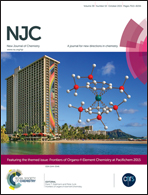Synthesis and structural characterization of amido heteroscorpionate rare-earth metal complexes and hydroamination of aminoalkenes†
Abstract
The synthesis, characterization and fluxional behaviour of novel heteroscorpionate rare-earth (including the group 3 metals, scandium and yttrium) complexes are reported. The reaction of acetamide and thioacetamide heteroscorpionate protio-ligands pbptamH, tbptamH, pbpamH and (S)-mbpamH with 1 equivalent of tris(silylamide) precursors [M{N(SiHMe2)2}3(thf)n] (n = 1, M = Sc; n = 2, M = Y, Lu) proceeded to give good yields of neutral heteroscorpionate disilylamide complexes [M{N(SiHMe2)2}2(κ3-pbptam)(thf)n] (M = Sc, n = 0, 1; M = Y, n = 1, 2; M = Lu, n = 1, 3), [M{N(SiHMe2)2}2(κ3-tbptam)(thf)n] (M = Sc, n = 0, 4; M = Y, n = 1, 5; M = Lu, n = 1, 6), [M{N(SiHMe2)2}2(κ3-pbpam)(thf)n] (M = Sc, n = 0, 7; M = Y, n = 1, 8; M = Lu, n = 1, 9) and [M{N(SiHMe2)2}2{κ3-(S)-mbpam}(thf)n] (M = Sc, n = 0, 10; M = Y, n = 1, 11; M = Lu, n = 1, 12). Scandium complexes were isolated as THF-free compounds with a pseudo five-coordinate environment, while yttrium and lutetium complexes were isolated with an octahedral geometry due to the coordination of a THF molecule. The fluxionality of complexes 1–12 in solution was investigated by VT NMR spectroscopy. The structures of these compounds were determined by spectroscopic methods and the X-ray crystal structure of 1 was also established. Complexes 1–12 are efficient catalysts for the intramolecular hydroamination of aminoalkenes, with TOF values up to 198 h−1 obtained at 70 °C for 2,2-diphenyl-pent-4-enylamine (13) using complex 11 as a catalyst. Enantioselectivities of up to 99% ee were achieved with the cyclization of aminoalkene 13 using the single enantiopure complex 12. The hydroamination reactions showed a zero-order rate dependence on substrate concentration and first-order rate dependence on catalyst concentration.

- This article is part of the themed collection: Frontiers of Organo-f-Element Chemistry

 Please wait while we load your content...
Please wait while we load your content...